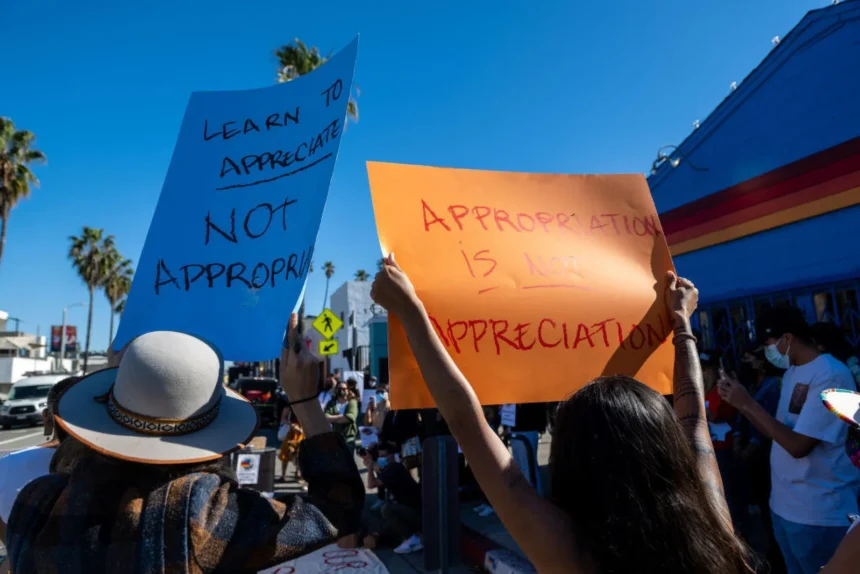Understanding the delicate balance between cultural appropriation and appreciation has never been more significant than in today’s interconnected world. As we stand at this crossroads, there is a beautiful opportunity ahead of us: to celebrate and share in the rich tapestry of global cultures that surrounds us.
However, alongside this opportunity lies a risk—the possibility of unintentionally stepping into appropriation by adopting elements of a culture without fully grasitating its significance or heritage.
This crucial distinction doesn’t just influence how we engage with different cultures; it also shapes our personal development and contributes to societal harmony.
Throughout my travels across numerous countries as an educator, I’ve been privileged to witness both the beautiful moments of respectful cultural exchange and the painful instances where cultural elements were taken without due care or understanding.
With years spent dedicated to fostering cross-cultural communication and emphasizing the value of diversity, I’ve come to understand how complex these interactions can be. It’s clear that navigating these sensitive conversations requires not only knowledge but also empathy.
So let’s journey together through this nuanced landscape, aiming for a deeper awareness and genuine respect for all cultures. By approaching our interactions with open hearts and minds, we can contribute to building a more inclusive world—one that celebrates differences while uniting us through our shared humanity.
Key Takeaways
- Cultural appropriation happens when elements from a culture are taken without understanding or respect, while cultural appreciation involves learning about and honoring another culture’s traditions.
- Engaging with local communities, participating in authentic experiences, and educating oneself on the history behind cultural practices can help travelers appreciate cultures without appropriating them.
- Celebrities wearing Native American headdresses or using Hindu symbols as fashion accessories are examples of cultural appropriation that sparked controversy.
- Respecting different cultures includes recognizing the significance of racial identity and power dynamics in interactions and avoiding reinforcing stereotypes.
- To respectfully appreciate other cultures, it’s important to understand their customs through open – minded conversations, participate in cultural events, and support local artisans by purchasing authentic products.
Understanding Cultural Appropriation and Appreciation
Understanding Cultural Appropriation and Appreciation is crucial. Differentiating between the two helps in respecting and valuing diverse cultures.
Definitions of both terms
Cultural appropriation involves taking elements from a culture not one’s own, often without understanding or respect. This act can reinforce harmful stereotypes and exploit marginalized communities.
It turns significant cultural symbols into trends, ignoring their deeper meanings. On the other hand, cultural appreciation means genuinely seeking to understand and honor another culture’s traditions and expressions.
It involves learning about the culture, sharing experiences respectfully, and celebrating its contributions without attempting to claim them as one’s own.
I strive to appreciate cultures in my travels by engaging with local people, participating in authentic cultural exchanges, and educating myself on the history behind cultural practices.
Recognizing the fine line between appropriation and appreciation is crucial for travelers like me who wish to experience different cultures ethically. Acknowledging the significance of cultural elements without appropriating them ensures that our interactions remain respectful and enriching for all involved.
Let’s explore some examples of how these dynamics manifest in various aspects of life.
Why it is important to know the difference
Understanding the difference between cultural appropriation and appreciation is crucial for fostering respect and inclusivity while exploring diverse cultures. It helps in acknowledging the significance of cultural elements without exploiting or misrepresenting them.
By recognizing this difference, we honor the authenticity of various traditions and contribute to a more harmonious cross-cultural exchange. Moreover, it’s not merely about being aware but also actively making informed choices to appreciate rather than appropriate, thus promoting mutual understanding and dismantling harmful stereotypes.
Recognizing the distinction between cultural appropriation and appreciation is pivotal as it underpins our interactions with different communities. It guides us towards engaging authentically with other cultures, seeking more than just surface-level fascination or fleeting trends.
Instead, we can embark on meaningful experiences that are designed to enhance our understanding of diverse customs and nurture genuine connections with people from varied backgrounds.
ALSO READ: Fusion Cuisine: Exploring Delicious Cross-Cultural Culinary Creations(Opens in a new browser tab)
Examples of Cultural Appropriation
1. Celebrities wearing traditional Native American headdresses without understanding their significance sparked controversy.
2. Using Hindu religious symbols as fashion accessories has been seen as disrespectful by many.
In fashion
In fashion, cultural appropriation occurs when designers use elements from a specific culture without understanding or respecting their significance. This can lead to misrepresentations and the exploitation of traditional clothing, accessories, or symbols for personal gain or trends.
It’s important as travelers interested in experiencing different cultures and lifestyles to be aware of the impact our fashion choices may have on marginalized communities. By seeking genuine appreciation rather than imitation, we can support ethical consumption and celebrate cultural diversity.
On the other hand, cultural appreciation in fashion involves genuinely respecting and acknowledging the significance of traditional clothing, textiles, and designs from various cultures like Africa or Asia.
In music
Music is a powerful medium for cultural expression. It embodies the traditions, history, and emotions of different communities. From my experiences traveling, I’ve seen how music can both bring people together and reflect the diversity of cultures.
However, it’s crucial to understand that the line between cultural appreciation and appropriation in music can be blurry. For instance, taking elements from a culture without understanding their meaning or significance crosses into appropriation territory.
Recognizing this difference is vital because music holds great value in many cultures. By genuinely learning about the background and context of musical styles or instruments, we show respect for their origins.
In literature
Literature can reflect cultural appropriation when authors misrepresent or exploit elements of a culture for their own gain, reinforcing harmful stereotypes and misunderstandings. It’s crucial to approach literature with sensitivity, respecting and acknowledging the significance of cultural elements without appropriating them.
Genuine cultural appreciation in literature involves understanding and celebrating diverse perspectives without exploitation or mimicry.
Cultural appreciation in literature acknowledges the importance of different cultures and seeks to genuinely learn from and respect them. By embracing this approach, we can foster understanding, break down stereotypes, and promote inclusivity through our literary experiences while avoiding the pitfalls of appropriation.
In everyday life
In everyday life, I always strive to learn about and appreciate different cultures. This can be as simple as trying new foods at an authentic restaurant or attending cultural events in my community.
By engaging with diverse traditions and customs, I gain a deeper understanding of the world around me.
I also make an effort to consciously avoid appropriating elements of other cultures in my daily life. For example, when choosing clothing or accessories, I consider the cultural significance behind them before incorporating them into my personal style.
The Impact of Cultural Appropriation
Cultural appropriation can perpetuate stereotypes, undermine the significance of cultural practices, and cause harm to marginalized communities. For more insights on this vital topic, read the full blog post.
On marginalized communities
Marginalized communities face exploitation due to cultural appropriation, reinforcing harmful stereotypes and disregarding their authenticity and significance. Exploitation heightens societal inequalities, undermining the cultural heritage of these communities.
It also perpetuates power imbalances, leading to further marginalization based on race and ethnicity.
Cultural appreciation is vital in uplifting marginalized communities by acknowledging their cultural contributions with respect and understanding while actively combating appropriation.
On power dynamics
Navigating through cultural dynamics, it’s crucial to acknowledge the impact on power dynamics. The act of appropriating elements from a marginalized culture often reinforces existing power imbalances.
This can perpetuate stereotypes and exploit the cultural heritage of these communities, leading to further marginalization and disempowerment. Understanding this dynamic is essential in fostering respectful cross-cultural interactions, ensuring that appreciation comes from a place of equity and empowerment.
Recognizing the influence of power dynamics within cultural exchanges is vital for travelers seeking authentic experiences. Being mindful of how one’s actions may affect marginalized communities is an integral part of cultural appreciation.
On social justice
Moving from power dynamics to social justice, it’s crucial to acknowledge that cultural appropriation can perpetuate unfair power structures and further marginalize already oppressed communities.
Social justice seeks equality and fairness for all, and cultural appropriation can undermine these efforts by reinforcing harmful stereotypes and exploiting the traditions of marginalized cultures.
It is essential to recognize and respect the significance of various cultural elements without perpetuating exploitation or misrepresentation.
Cultural appreciation, on the other hand, aligns with social justice by promoting genuine understanding, respect, and celebration of diverse cultures without exploitation or harm. Appreciating other cultures fosters inclusivity and understanding while working towards a more just society where all voices are valued equally.
On racial identity
Racial identity plays a crucial role in cultural appropriation and appreciation, shaping how individuals are perceived in different contexts. Acknowledging the significance of racial identity without exploitation is essential when interacting with diverse cultures.
Cultural misappropriation can perpetuate harmful stereotypes and impact the dignity and worth of marginalized groups. Understanding this dynamic is vital for fostering inclusive and respectful cross-cultural interactions that honor diverse racial identities.
Appreciating different racial identities fosters understanding and respect among communities, challenging biases and stereotypes while promoting inclusivity. Recognizing the impact of racial identity on cultural dynamics enables meaningful engagement with various cultures, contributing to a more harmonious global society.
Respecting racial identity underpins genuine cultural appreciation, fostering empathy and unity amid diversity.
Navigating Sensitive Conversations
Understanding and addressing cultural appropriation, appreciating other cultures respectfully, and recognizing the importance of listening and learning. The significance of navigating these sensitive conversations for a more inclusive world.
How to recognize and address cultural appropriation
Recognizing cultural appropriation involves understanding the context and history behind certain cultural elements. It’s important to be aware of power dynamics and how they influence the adoption of these elements.
Addressing cultural appropriation requires actively listening and learning from marginalized communities affected by it, as their perspectives are crucial in understanding its impact.
Engaging in open conversations about cultural exchange and being receptive to feedback is essential for recognizing and addressing instances of appropriation.
It’s also vital to approach other cultures with genuine curiosity, respect, and empathy. When encountering unfamiliar cultural practices or symbols, take the time to learn about their significance without appropriating them for personal gain or validation.
Being mindful of our own actions, choices, and attitudes towards different cultures helps to prevent unintentional appropriation while fostering a spirit of appreciation rather than exploitation.
The importance of listening and learning
Understanding and respecting cultural differences is crucial for travelers like us. Being open to learning about different cultures allows us to appreciate their significance without appropriating them.
It’s essential to listen and absorb knowledge about various traditions, values, and practices without imposing our own beliefs. Recognizing the impact of cultural appropriation on marginalized communities is vital when engaging with diverse cultures.
By actively listening, we can foster meaningful connections and enrich our travel experiences authentically.
Navigating sensitive conversations about cultural appreciation enables us to embrace diversity respectfully while avoiding harmful stereotypes or exploitation. Embracing this mindset helps us form genuine connections with individuals from different backgrounds, leading to more meaningful and impactful travel experiences.
Ways to respectfully appreciate other cultures
Respectfully appreciate other cultures by seeking to understand and learn about their traditions, customs, and values. Engage in open-minded conversations with members of the culture and actively listen to their experiences to gain insight into their way of life.
Embrace cultural diversity by participating in cultural events and celebrations, showing genuine interest in learning about different practices.
When traveling to new destinations, show respect for local customs and traditions by familiarizing yourself with basic phrases in the local language and practicing them when interacting with locals.
Conclusion
Understanding and respecting cultural differences is crucial for fostering a more inclusive society. To explore this further, I urge you to read the full blog post.
The importance of understanding and respecting cultural differences
Understanding and respecting cultural differences is crucial when immersing in diverse cultures. This involves genuinely appreciating the significance of different customs, traditions, and beliefs without exploiting or misrepresenting them.
It’s about acknowledging the value of each culture’s unique elements and celebrating their diversity.
When traveling, it’s essential to approach new cultures with an open mind, a genuine desire to learn, and a respectful attitude. Cultural appreciation goes beyond merely observing; it involves actively participating in local customs and traditions while being mindful not to appropriate them.
By understanding and respecting cultural differences, we can forge meaningful connections with people from different backgrounds and contribute positively to the communities we encounter.
The role of ethical consumption in cultural appropriation and appreciation
Understanding and respecting cultural differences is crucial when it comes to the role of ethical consumption in cultural appropriation and appreciation. It’s not merely about purchasing souvenirs or trying traditional foods.
Ethical consumption involves meticulously considering the impact of our purchases on the cultures we engage with, acknowledging that not only does authenticity matter, but also who benefits from our spending.
Embarking on a journey to appreciate diverse cultures through mindful consumption means seeking more than just a superficial experience. One must dive into understanding the stories behind products, supporting local artisans and businesses, and being conscious of fair trade practices.
FAQs
1. What is the difference between cultural appropriation and cultural appreciation?
Cultural appropriation happens when someone uses elements of a culture they’re not part of without understanding or respect, often in a way that can be harmful or offensive. Cultural appreciation, on the other hand, involves learning about, understanding, and respecting another culture’s traditions in a way that honors them.
2. Can you give examples of cultural appropriation vs. cultural appreciation in fashion?
An example of cultural appropriation in fashion might be wearing traditional clothing from another culture as a costume without understanding its significance. An example of cultural appreciation would be wearing an item gifted by someone from that culture while recognizing and honoring its importance.
3. Why is it important to appreciate other cultures correctly?
Correctly appreciating other cultures helps build mutual respect and understanding across different communities. It encourages sensitivity towards others’ heritage and promotes positive cross-cultural communication.
4. How can I avoid culturally appropriating music or literature?
To avoid culturally appropriating music or literature, learn about the background and context behind these works before sharing or using them. Make sure your actions don’t disrespect or misrepresent the original culture’s intentions.
5. What steps can I take to navigate sensitive conversations around cultural appropriation vs. appreciation?
When navigating sensitive conversations around this topic:
– Listen more than you speak.
– Educate yourself on different cultures.
– Ask questions respectfully if you’re unsure.
– Acknowledge any mistakes made along the way.
These steps help promote deeper cultural understanding and sensitivity during discussions about cultural differences.









